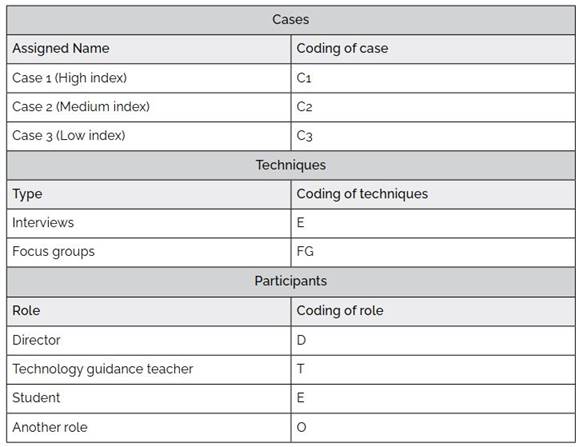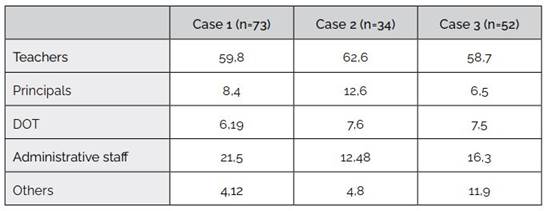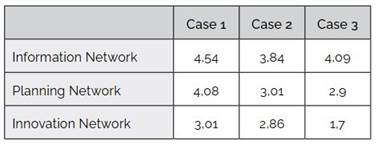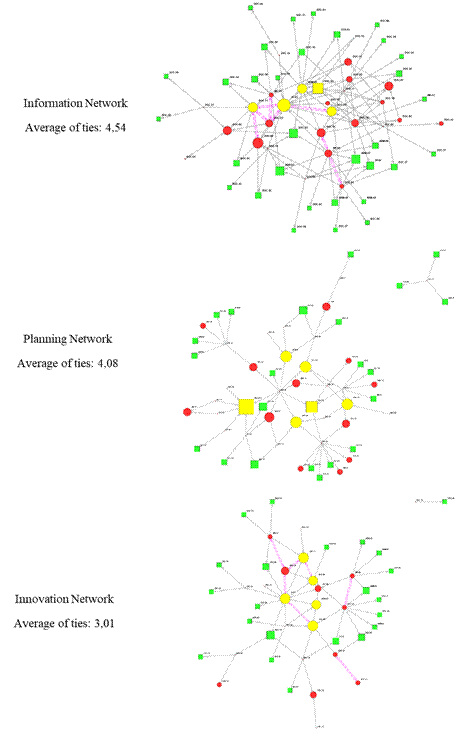Introduction
This article addresses the creation of professional learning communities as a form of interrelation among teachers, generating diverse results that impact student learning (Krichesky & Murillo, 2011). Previous studies on this topic have been carried out in educational systems of different countries (amongst the most recent ones: Brown et al., 2018; Feldman, 2020; Hairon et al., 2019; Prenger et al., 2018; Rigney et al., 2021). Even though some of these investigations focus on different aspects of professional learning communities, generally, they agree in highlighting that this level of organization among teachers favors professional development based on critical reflection and evidence-based practices, increases teachers' well-being, and improves motivation for work (Antinluoma, 2018; Cholifah & Oktaviani, 2019; Donoso, 2020; Vaillant, 2019). On the other hand, the constitution of these communities influences how organizational knowledge is created and developed ( Rodríguez-Gómez, 2015). Other studies on professional learning communities in educational centers with different characteristics and levels have emphasized aspects such as the professional skills of teachers and the organizational climate, pointing them out as critical components for the constitution of communities (D'Ardenne et al., 2013; Dogan et al., 2015; Ning et al., 2015; Owen, 2014).
Even though academics agree in highlighting some results and components of this way of organization amongst teachers, the concept of professional learning communities is multifaceted. It can refer to a small team of teachers that collaborate to produce learning among colleagues within the organization (Owen, 2014), or, to the extent collaboration goes beyond the different groups, it transforms into a work culture that involves the whole educational center (Vangrieken et al., 2015).
In keeping with previous studies and regarding the development of professional learning communities (Lizcano & Hennig, 2022), it is fundamental to understand teachers' relationships, that is, to diagnose interactions that happen within the organization to visualize to what extent groups are transformed into collaborative teams (De Dios, 2020). To achieve this insight, network analysis proves to be an ideal tool. The works of Scott (1990), Wasserman & Faust (1994), and Carrington et al. (2005) delve into the methodology of this analysis, initially used in the field of sociology, while Morales (2011), Baker-Doyle (2014), Carolan (2014) and Froehlich et al. (2020) raise the relevance of its use in the educational field.
In any case, social network analysis at the educational institution level makes the interactions based on collaboration among teachers visible, allowing one to focus on the role that ties play at the individual, group, and organizational levels (Hargreaves & O'Connor, 2018).
The characteristics of the interactions among educators influence the individual, social, and professional capital and result in the constitution of professional learning communities (Hargreaves & Fullan, 2012; Questa-Torterolo, 2018).
The impact of interrelations in different aspects of professional activity, such as pedagogical innovation and improvement of student learning, will partially depend on whether the type of tie developed within the networks is strong or weak (Quinn & Kim, 2018; Spillane et al., 2014). Likewise, the type of tie generated influences the characteristics of the community formed by the teachers. Groups of teachers can achieve professional learning communities or remain in stages that imply lower levels of professional involvement. These stages, systematized by Vangrieken et al. (2015), usually imply weaker or less interactions, with less incidence of collaboration for collective learning, fewer opportunities for joint reflection, and scarce knowledge management initiatives (Questa-Torterolo, 2018). Implementing a professional learning community can also remain in the teachers' collective imagination, at the discourse level, or in superficial changes in the working practices. When this happens, Dufour & Reeves (2016) call this stage a professional learning community lite.
When communities work towards collaboration and learning, social relations among teachers arise, identified by Carolan (2014) and Sun et al. (2014) as facilitators of access to information, change in pedagogical practices, and innovation. In the context of this research, innovation is understood as the implementation of new or improved ideas, knowledge, or pedagogical practices in education, either at the level of teaching processes or at the level of the educational organization (Organisation for Economic Cooperation and Development (OECD), 2016).
As a consequence of the operation of the teachers' networks formed by individuals oriented toward formal professional development, work synergies facilitate innovation and can influence both interactions within the organization as well as their results (Hopkins et al., 2013; Penuel et al., 2012). In these scenarios, the inclusion of technologies provides a differentiator for the professional learning communities, facilitating relationships among colleagues, favoring knowledge creation, ensuring its dissemination, and strengthening professional learning. Therefore, teams of teachers taking advantage of technology to favor collaborative work and peer-to-peer interrelations results in the improvement of the professional capital of the organization (Hargreaves & Fullan, 2012).
As López et al. (2018) described, social network analysis has been used in different educational research contexts, such as higher education and pedagogical leadership. It has also been used at the primary educational level, delving into different aspects of the impact of network collaboration (Garay et al., 2019; Sannen et al., 2021). For instance, a recent study in schools by Sinnema et al. (2020) uses social network analysis to explore communities of practice based on three key concepts: leadership, experience, and networks articulated by collaboration and advice.
According to the focus of this research, the previous studies from Van Waes et al. (2017) on teachers' networks in higher education are relevant. On the other hand, little is delved into the teachers in the teacher education program. However, as a mirror to collaboration among teachers and the measuring of its impact, the works of Civís et al. (2017), Gómez et al. (2015), Liou et al. (2016), and Tomàs et al. (2016) are key. These studies incorporate network analysis from the student teachers' perspective. However, despite the increase in the last decades in the number of investigations that relate digital technologies with norms of social behavior that foster communities (Antoci et al., 2012; Bauernschuster et al., 2012; Burke et al., 2011; Camacho et al., 2020; Ellison et al., 2007), studies that use social network analysis among teacher trainers to make the impact of these interactions visible in aspects such as innovation or digital inclusion with pedagogical aims are still scarce.
In this study, we propose to use social network analysis of teachers in three teacher education centers for teachers and professors in Uruguay to determine the articulation of the ties in four aspects: innovation initiatives, information exchange, digital inclusion, and collaboration in planning, and to determine to which extent a professional learning community has been achieved in each case. In this context, it should be noted that despite the universal access to digital resources in education-particularly in teacher education-achieved by Plan Ceibal in Uruguay (Fundación Ceibal, 2020), different studies show that digital inclusion is scarce for the development of teachers' digital skills, while the use and impact of educational technologies in teaching is not made visible in the students' learnings (Cabrera Borges et al., 2018; Morales et al., 2020; Silva et al., 2018, 2019).
Therefore, this study is justified by the need to strengthen Teacher Education Institutions to improve education and the relevant role that digital tools and platforms may have in the constitution of professional learning communities. Among the diagnostic options is the teachers' networks analysis that supports collaborative processes.
The article reports part of the results of a larger study with several stages in which teacher training centers in Uruguay and Chile participated. For this contribution, based on identifying and characterizing public educational institutions for teacher training in Uruguay, we sought to identify, characterize, and represent the different types of interactions that occur in the context of teacher training communities. These results arise from analyzing social networks between actors of the selected centers.
Methodology and development
This study had a previous quantitative data collection stage in 2019 when a self-administrated online questionnaire (Redes e Inclusión Digital, 2019) was sent to 32 principals of public educational centers of teacher education in Uruguay, and 27 answers were received. Based on the data collected, three indexes were created to measure the dimensions of the questionnaire according to the technology usage level (high, medium, low), achievement of deep learning, the constitution of professional learning communities, and a fourth general index. The latter allowed to compare centers to select three cases based on how much they incorporate the dimensions mentioned above in their teaching practices.
Based on the questionnaire, the quantitative stage constituted the basis for selecting the centers. However, representing geographically different areas of the country was also considered when choosing the case studies and avoiding location proximity among them. Once the cases were selected, in-depth interviews were conducted with key stakeholders, including informants in each center's managerial roles, teaching roles, and experts in educational technologies. The interviews sought to delve into the following dimensions of analysis: general assessment of the incorporation of ICTs into teacher education, professional learning communities, strengths and weaknesses of incorporating digital technologies for deep learning, and innovative activities. Fifteen interviews were conducted, which were mediated by video conferencing tools in the face of the COVID-19 emergency in 2020.
Then, an online survey (Redes e Inclusión Digital, 2020) was applied for the social network analysis in each of the selected centers. The main dimensions considered were the ties related to the exchange of information, teacher planning, pedagogical innovation, and activities outside the workplace. In this sense, relevant measures were taken regarding density -the proportion between possible contacts and declared contacts- and centrality -the higher number of relationships that nodes concentrate- (del Fresno García et al., 2016). The instrument was sent to all the teachers of the selected centers, from which 73 responses were obtained. Data were processed with Visone (to represent the networks in graphs) and Ucinet software (to carry out the analysis of networks properly), which facilitated the creation of graphs of the existing social networks in each center.
Finally, a focus group in each teacher education center was conducted, with a total of 19 participants. The script for the focus group incorporated the following topics: digital technologies, professional learning communities, and innovation. This technique was also conducted via video conferencing due to the suspension of in-person instruction in all educational centers and the health protocols in force in the country. The transcription of the interviews and focus groups were processed in Atlas.ti, considering the dimensions mentioned above. The strategy for data analysis presented proposes the comparison of the three chosen cases. Table 1 shows the code and techniques for each case, according to the involved stakeholders.
The results presented in this article focus fundamentally on the network analysis obtained from processing the data that emerges from the questionnaire applied in each of the three selected cases in Uruguay (Redes e Inclusión Digital, 2020).
Results and Discussion
In this section, as was mentioned, the focus of the presentation will involve aspects related to social network analysis, considering the objective of the article: identify, characterize, and represent the different types of interactions that occur in the context of teacher training communities (Sannen et al., 2021). Therefore, the information is organized from the broad characteristics of the considered networks to the particularities in each case and each type of interaction.
General characteristics of the networks in each of the three cases studied
One often identified aspect is that half of the contacts occur internally in the academic department's context (Consejo de Formación en Educación (CFE), 2008). One plausible interpretation is that, even though academic departments are a strong nucleator of ties in the studied centers, they are not the only context in which they happen; a substantial proportion of contacts occur among actors from different departments. It should be noted that in the teacher education centers in Uruguay, the teachers are the only actors that belong to (only) one department.
Another confirmed aspect was the stability of the center's academic staff. When considering this variable, it is assumed that the longer they have been working in the center, the higher the number of ties. In this regard, it is verified that Case 1 has a more stable academic staff than the others because the higher percentages are in the most senior groups (Table 2).
Table 2: Percentage of ties according to the seniority of the respondents
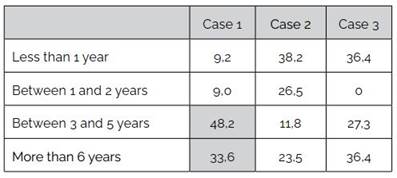
Note. Case 1 shows a greater degree of permanence of teachers in the institution compared to Case 2 and Case 3, as indicated in shaded.
Closely related to the above, it is interesting to know among which stakeholders the ties happen. In order to do that, it is helpful to analyze the percentage of ties identified for each sector: Teachers, Principals, Technological Guidance Teachers (DOT as per its Spanish acronym), administrative staff, or others (Table 3).
From the analysis of Table 2, it can be said that teachers are those who show a higher percentage of ties at the institutional level and that there are no significant differences in this regard among the centers. These data are relevant if one considers what Carlona (2014) and Sun et al. (2014) mention; the authors state that ties among teachers favor access to information and innovation. In addition, ties also influence the individual, social, and professional capital of those involved (Hargreaves & Fullan, 2012).
A fact that deserves reflection is the percentage of ties attributed to the DOT; though not high, they are relevant stakeholders in managing digital technologies in the center. It is worth highlighting that this role is filled by at most three people in each institution (in the cases studied, the number ranges between one and three). The relevance of the DOT as a key stakeholder that supports other teachers in the process of incorporating digital technologies in the classroom emerges from the interviews with the principals of every center:
"DOTs are indirect teaching positions; they stay longer in the institution. There is more time for anything related to being able to think, plan that disposition, and say, `OK, I am going to go to my colleague’s classroom because I have this schedule that allows me to join their class or to join the schedule of the office hours´.” (C2ED)
“…we put together our shifts and ensure that there is never a lack of a guidance teacher, who has the opportunity to be in more than one shift, (…), the DOT, who one goes in one shift, and another goes in a different one, and teachers can count (on them)." (C1ED)
"That you can count on the support of the DOT, who are those who know the devices the most, and in turn, also strengthen the ties and from there, that ties remain established, which may allow, let's say, obviously, that tomorrow these things continue and grow." (C3ED)
On the other hand, the number of ties between principals, administrative staff, and other stakeholders shows that these are centers where the networks involve actors from every level and are not restricted only to teachers. This fact becomes relevant if one considers what Vangrieken et al. (2015) state with regard to how collaboration goes beyond different groups, which would evidence that there is a sign of work culture at the center level.
From the network analysis, it is concluded that in the three cases, a clear decrease in the network's density can be noted when one moves from the Information network to the Planning network and finally to the Innovation one. Table 4 shows how this is a recurrent phenomenon in all three cases studied.
In an attempt to graphically show the representation of the low density of the networks mentioned above, Figure 1 shows how the variation for Case 1 is appreciated.
Contribution of the analysis of each network
In the Information Network, it is appreciated that there are almost no differences in the average of ties when comparing the different centers (Table 4). This network shows the highest average number of contacts per actor and the highest density, which reflects a relevant level of cohesion when considering all the people who work in the center. This becomes relevant if one considers that the Information Network lays the necessary foundations for innovation to take place (Carolan, 2014; Sun et al., 2014).
The central points in these networks are, in all cases, occupied by teachers and administrative staff.
In Case Studies 1 and 2, it is appreciated that principals also occupy a position of centrality. When triangulating the data that emerge from the network analysis with what comes from the interviews, it is possible to appreciate that for these cases, the role of the principal is also seen as relevant by the different stakeholders of the center:
"The school administration is really, really open. They are genuinely waiting for us to propose things. But it seems we are waiting to receive proposals to actually start working." (C1EP)
"It is an ideal place to grow professionally in this sense because first, the headmistress is great in that sense. She is always supporting the activities of all teachers". (C2ET2)
It should be noted that the principal of Case Study 3 changed several times (from the beginning until the end of the investigation, three different people in that role were identified).
In Case Studies 2 and 3, the DOT are added as roles that occupy central positions (Table 5), which could indicate that the management of digital technologies becomes instrumental in facilitating the movement of actors in the studied centers, and this, in turn, influences the constitution of professional learning communities (Van Waes et al., 2017).
Regarding the Planning Network, it is possible to appreciate that those who occupy positions of centrality are the teachers (Table 6).
In Case Study 2, just as happened with the Information Network, the Planning Network is the one that shows more significant levels of diversity in the type of actors occupying positions of centrality. In this case, the presence of the principal is identified, as well as one of the institution's DOT. Case Study 2 was characterized as medium level based on the self-perception survey filled by the principals. However, these results show that concerning these aspects, it could be said that it presents advantages compared to the case that occupies level 1. It is worth mentioning that the difference in the degree of appropriation verified in Case 1 was very small compared to Case 2.
On the other hand, the Innovation Network of the centers identified in the first stage as high and medium regarding technological inclusion have central positions of the network actors from more than one level (teachers, principals, and administrative staff). However, in the case of the center that was identified as low in the index, those who occupy the central points are all teachers (Table 7). As stated by De Dios (2020) and Lizcano & Hennig (2022), to diagnose interactions tending to collaboration in the centers, visualizing and understanding the relationships between teachers is crucial to promoting individual and professional capital in the organizations.
Data for Case Studies 1 and 2 show that, for tasks associated with innovation initiatives, other actors different from teachers emerge in positions of centrality in the networks.
After analyzing the three types of networks for each case, it is possible to appreciate that there is a relationship between the levels of the centers identified in Stage 1 (high, medium, and low) and the number of ties identified in the different networks. Even though the center classified as low-level has a high number of ties in the information network, in the planning and innovation ones, it is clearly appreciated that there is a higher number of ties in the center classified as high-level, followed by the medium-level one, and last, the low-level one (Table 4).
Conclusions
The main contribution of this research is to provide empirical evidence of the existence and characteristics of professional learning communities in three teacher education centers in Uruguay, as well as the factors that influence their development. Additionally, this study contributes to understanding the dynamics and challenges of professional learning communities in the Uruguayan context. The findings suggest that the level of digital inclusion for learning is positively associated with the diversity and strength of the networks among teachers and professors, especially in terms of information exchange and collaboration in planning. Moreover, the results indicate that innovation initiatives are not widespread or well-supported in the studied centers, which may limit the potential for improvement and change in teacher education practices.
In summary, from the data analysis, it is possible to affirm that the case studies show characteristics that, in keeping with Dufour & Reeves (2016), can be identified as professional learning communities lite.
Evidence shows that it is possible to appreciate professional communities, even incipient ones. They are present in the information networks of the three centers that show a high level of cohesion given by the number of ties per person and the network density. Another aspect is the diversity of the type of actors in the different networks since, in no case is this limited only to teachers.
On the other hand, an indicator of limited development is the decrease of the density in the networks. Though high in the circulation of information, the density is then lost in the planning and innovation. Another indicator may be that most of the ties occur within the academic department, which, although logical, could be detrimental to the community's cohesion as a whole. From the qualitative data, it is also possible to find indicators showing an incipient community development in the three cases studied.
The limitations of this research can be listed in the following. First, selecting of one case per level of digital inclusion may introduce bias or overlook variations within each level since afterward, the focus of the social network analysis discards the active use of technology regarding the innovation or the planning aspects surveyed. Second, the information-gathering techniques used for the analysis in this article (interviews and survey) may be subject to social desirability or recall bias and may not capture the actual behaviors or practices of the participants in their professional communities. Finally, the team is aware that the definition of professional learning communities lite may not be universally accepted or validated and may limit the generalizability or applicability of the findings to other contexts or settings.
Nevertheless, this study has important implications for policymakers, educational leaders, and researchers interested in promoting professional learning communities as a strategy to enhance teacher education quality and outcomes. Further studies are needed on professional learning communities in the field of education, using different methodologies and approaches to deepen the understanding of their characteristics, processes, and effects on education in general. Moreover, studying this kind of community in the context of initial teacher training is important.














